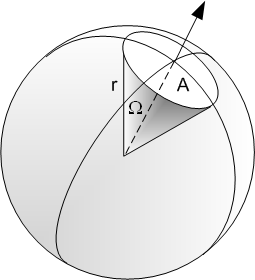Radiometric and photometric quantities
Electromagnetic radiation is a carrier of energy that spreads from a source in which the supplied energy (electrical, chemical, etc.) is transformed into radiation energy. The emission and transfer of energy by radiation of all wavelengths of the spectrum is investigated by radiometry , electromagnetic radiation in the optical band is dealt with by photometry. The power of the source is given in units of W.
Which radiometric quantities correspond to photometric quantities is written in the table.
| radiometric quantity | symbol | unit | photometric quantity | symbol | unit |
|---|---|---|---|---|---|
| luminosity | W·sr−1 (watts per steradian) | luminosity | cd (candela) | ||
| radient flow | W (watt) | luminous flux | lm (lumen) | ||
| radiation intensity | W·m−2 (watts per square meter) | lightness | lx (lux) | ||
| heat | W.sr-1.m-2 (watts per steradian per square meter) | brightness | nt (nit) | ||
| exposure | W.s.m-2 (watt second per square meter) | exposure | lx.s |
Radiometric quantities[edit | edit source]
Radiometric quantities are defined for all types of electromagnetic radiation . They are also used for types of radiation that cannot be perceived by the human eye.
Radiance expresses the ability of a given approximately point source to radiate in the observed direction, it is determined by the proportion of the elementary luminous flux and the elementary spatial angle in which this flux is emitted.
Radiant flux expresses the power transmitted by radiation, i.e. it is the amount of radiated energy related to a very short time interval (i.e. the derivative with respect to time).
The radiation intensity expresses the power falling on the surface.
The radiance is determined by the ratio of the radiance of the elementary surface of the source in the selected direction and the perpendicular diameter of the surface in this direction.
Exposure is the surface density of radiant energy that fell on a given surface in the time interval from to= 0 to t – it is the product of the average intensity of radiation and the time for which the radiation is active.
Analogous relationships apply to radiometric quantities as for photometric quantities.
Photometric quantities[edit | edit source]
Photometric quantities are limited only to radiation visible to the human eye . They are defined according to the spectral sensitivity of the human eye and are therefore dependent on the color composition of the investigated radiation (the human eye is most sensitive to yellow-green light with a wavelength of 555 nm). They are historically older than radiometric.
Luminance indicates the spatial density of light flux of the source in different directions. Luminosity can only be determined for a point source, i.e. for a source whose dimensions are negligible compared to the distance of the source from the control point. It expresses the ability of an approximately point source to induce visual perception in a given direction. Luminosity is a basic photometric quantity.
Luminous flux expresses the amount of light energy transmitted by radiation or emitted by a source per unit of time, taking into account the sensitivity of the average human eye to different wavelengths of light. It expresses the ability of a luminous flux to produce a visual sensation.
Illumination is determined by the proportion of the luminous flux and the content of the area on which this flux falls.
The brightness is determined by the ratio of the luminosity of the elementary surface of the source in the selected direction and the perpendicular projection of the surface in this direction.
Illuminance is the surface density of the amount of light that fell on a given surface in the time interval from t0 = 0 to t – it is the product of the average illumination and the time t during which the illumination is active.
- = solid angle (sr),
- = display surface,
- = radius of light cone,
- = luminosity,
- = luminous flux,
- = lighting.
Links[edit | edit source]
Related Articles[edit | edit source]
- Photometry
- Light absorption
- Beer's Law
- Lambert-Beer law
- The refractive system of the eye
- Refractive defects
- Methods of correction of refractive errors
- Photosensitive cells and their functions
- Spectral sensitivity of the human eye
- Light bulbs, luminescent radiation sources, discharge lamps
- Lasers
- Optical radiation detectors
External links[edit | edit source]
References[edit | edit source]
- NAVRÁTIL, Leoš – ROSINA, Jozef. Medicínská biofyzika. 1. edition. Grada, 2005. 524 pp. ISBN 80-247-1152-4.
- HRAZDIRA, Ivo – MORNSTEIN, Vojtěch. Lékařská biofyzika a přístrojová technika. 1. edition. Neptun, 2001. 396 pp. ISBN 80-902896-1-4.


















